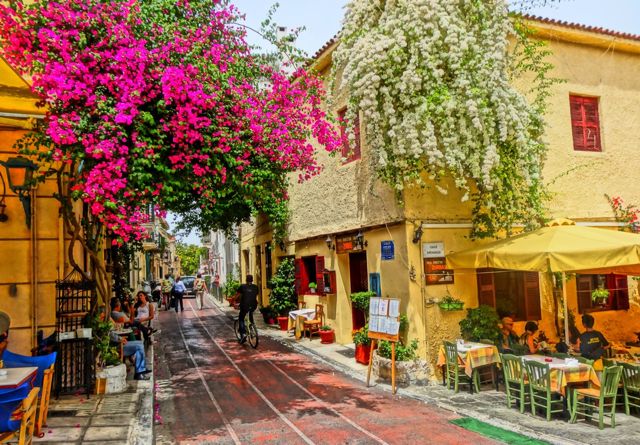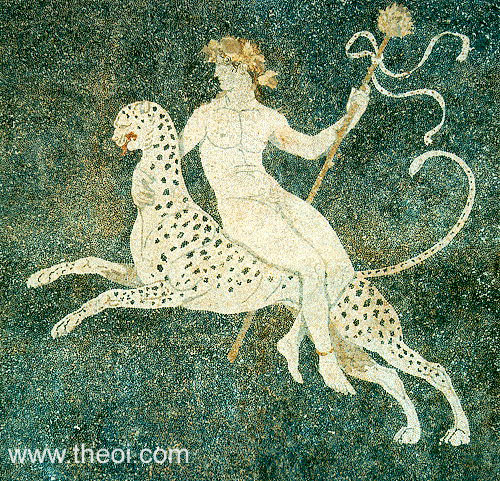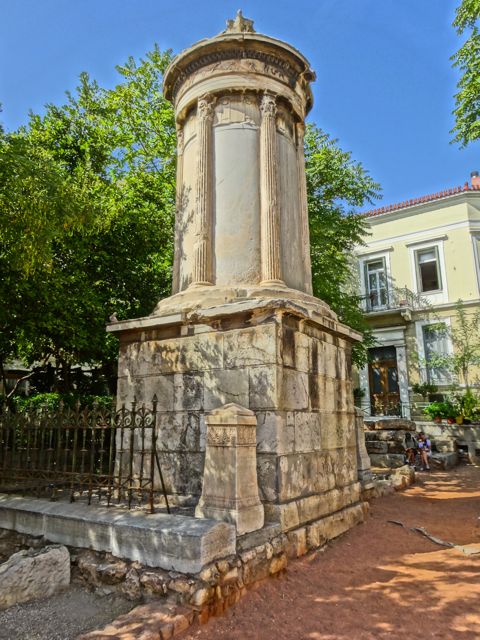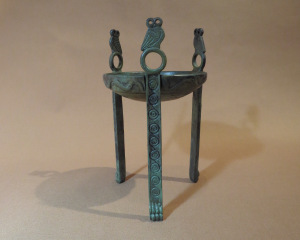
Tripodon Street is the most ancient street in Athens. It has retained its name for over 2500 years. It has been recorded in the Greek record book Guinness as the oldest street. The Athenians would walk along the 800 metre length and 6 metre width street to reach the theatre of Dionysos, which held 17,000 spectators. Under the magical Attica sky, the ancient Athenians, just as today, would take pleasure in the works of the great writers of tragedy and comedy.

The name ‘Tripodon’ refers to the bronze tripods that were put along the street to commemorate the winner of the Greater Dionysia as part of the festival of Dionysos, a festival celebrating the arrival of the god Dionysos in Attica. The Olympian god Dionysos (Greek: Διόνυσος) was the patron of the arts, fertility,the grape harvest, winemaking and merriment. He was the son of Zeus and the princess Semele of Thebes.
Dionysos riding a panther –
Greek mosaic from Pella
C4th BC Pella Archaelogical
Museum
The Dionysia were originally a rural festival celebrating the cultivation of vines. The City Dionysia also known as the Great Dionysia was the urban part of the festival established in about 6th century BC between March-April during the vernal equinox. On the first day, a procession was held where the people marched to the Theatre of Dionysos carrying the wooden statue of Dionysos. Musical and theatrical competitions were then held under the auspices of the ‘choregoi’ (sponsors). They were wealthy Athenians who would finance the training and outfitting of choruses for dramatic and musical performances.
The Chorogic Monument erected in 334 BC by the choregos Lysikrates is the best preserved monument, built to commemorate the victory of a chorus in the Greater Dionysos. Each of the ten tribes of Attica would enter two choruses in the competition – one of fifty men and one of fifty boys. The poet who would write the song which they sang was chosen by the choregos (a wealthy sponsor-producer). The first prize for the poet of the winning chorus was a bull, the second an amphora full of wine and the third a goat. The victorious chorus received a tripod; a bronze cauldron with three legs and decorative ring handles. This trophy was dedicated to Dionysos, and placed on a monumental marble base inscribed with the names of the victors. The infamous Lord Elgin tried unsuccessfully to buy the monument in order to transport it back to Great Britain, but it was too cumbersome to move.

The Choragic Monument of
Lysicrates built in 334 BC
It is situated at the beginning
of the street.
 Bronze tripod, symbol of achievement, a prize for victory and a token of gratitude between host and guest.
Bronze tripod, symbol of achievement, a prize for victory and a token of gratitude between host and guest.
Famous people from Lord Byron to Palamas, Papdiamandis, Melina Mercouri and many more have walked along Tripodon Street, the street of of the theatre and the arts, to sit at its many coffee shops and taverns and to immerse themselves in the history that surrounds them. Lord Byron during his stay at the Capuchin Monastery located next to the Choragic Monument in one of his letters wrote about the beauty of the area: ‘In front of you is Hemettos, behind you the Acropolis, to the right the temple of Zeus, in front the Stadium, to your left the city. This is what you call picturesque. There is nothing similar in London nor in the residence of the Lord Mayor (of London)’. (The quote has been translated from the site: Μηχανη του Χρονου – Time Machine).
Next time you head towards the Herodotus Theatre, stop at the corner of Tripodon Street to admire a part of the history of the ancient theatre.
| Choragic Monument of Lysicrates
The Choragic Monument of Lysicrates near the Acropolis of Athens was erected by the choragos Lysicrates, a patron of many theatrical performances in the Theater of Dionysus, to commemorate the award of first prize in 335 BC or 334 BC, to one of the performances he had sponsored. The choragos was the sponsor who paid for and supervised the training of the dramatic dance-chorus. The circular structure, raised on a high squared podium, is one of the first Greek monuments built according to the Corinthian order. Its frieze sculptures depict episodes from the myth of Dionysus, the god whose rites developed into Greek theatre. It originally served as support for the bronze tripod that was given as prize. it stands now in its little garden on the Tripodon Street (“Street of the Tripods”), which follows the line of the ancient street of the name, which led to the Theater of Dionysus and was once lined with choragic monuments, of which the foundations were discovered in excavations during the 1980s. In 1658, a French Capuchin monastery was founded by the site; the monastery succeeded in purchasing the monument (then being called the “Lantern of Diogenes”) from the Ottoman resident (1669). The monument became famous in France and England through engravings of it, and “improved” versions became eye-catching features in several English landscape gardens. Lord Byron stayed at the monastery during his second visit to Greece. In 1818, friar Francis planted in its gardens the first tomato plants in Greece. In 1829, the monks offered the structure to an Englishman on tour, but it proved to be too cumbersome to disassemble and ship. Lord Elgin negotiated unsuccessfully for the monument, by then an icon in the Greek Revival. The monastery was demolished during the Greek war of Independence, 1821. French archaeologists cleared the rubble from the half-buried monument and searched the area for missing architectural parts. In 1876-1887 the architects François Boulanger and E. Loviot supervised a restoration under the auspices of the French Government. Famous English versions of the Choragic Monument appear in the gardens at Shugborough, Staffordshire and Alton Towers, among many others. In the US, the Choragic Monument was adapted for Civil War memorials in Connecticut [1], [2], and capped many Beaux-Arts towers. |